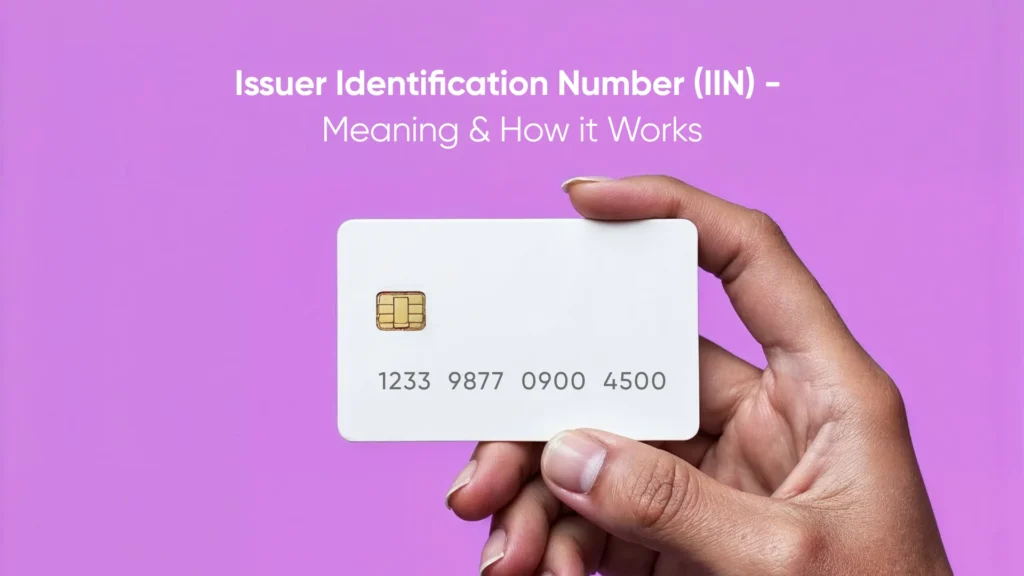Issuer Identification Number (IIN) - Meaning & How it Works

Have you ever wondered how payment systems instantly recognize your bank when you swipe, tap, or enter your card details? That is all because of the Issuer Identification Number (IIN).
The IIN is the first 6 digits of your card number that becomes the unique identifier for the bank or financial institution that issued your card. Whether you are using a debit card or a credit card, the IIN ensures that your transaction is routed to the right bank.
In this guide, we will understand what the Issuer Identification Number (IIN) is, how it works in digital payments, and why it plays a crucial role in India’s digital payments.
Table of Contents
ToggleWhat is an Issuer Identification Number (IIN)?
The Issuer Identification Number (IIN) is a six-digit code on a payment card like a debit or a credit card. It indicated which bank, or financial institution issued the card. IIN are sometimes also referred to as BIN (Bank Identification Number). They are found on various transaction cards like credit cards, debit cards and other payment cards.
Merchants and payment networks use the IIN to identify and route transactions correctly. As the issuing institution gets easily identified, IIN helps detect unauthorized or fraudulent transactions quickly.
For instance, a Visa card may have an IIN starting with 411111, where “411111” identifies the issuing bank within the Visa network.
Structure of an IIN
IIN is typically a 6-digit number. In some cases, it may be an 8-digit number, it depends upon the bank or issuer.
The first digit is the Major Industry Identifier (MII), indicating the card’s category (e.g., banking, travel or oil industry). Next five digits specify the issuing bank or institution, ensuring transactions are routed to the right entity. This system enables fast and secure processing of your card payments.
How Does an IIN Work?
IIN (Issuer Identification Number) plays a crucial role when you make a transaction with a card (debit or credit). Upon any transaction, the system begins by checking the IIN number.
When you swipe your card, the system reads the IIN to determine the card’s issuing bank.
Then it directs the transaction to the appropriate financial institution for processing. The process is completed in seconds, thereby making the payment fast and secure.
Difference Between IIN & BIN
IIN stands for “issuer identification number” and BIN stands for “bank identification number”. However, they have few minor differences as below:
Factor | IIN | BIN |
Full Form | IIN stands for Issuer Identification Number | BIN stands for Bank Identification Number |
Purpose | IIN identifies the issuer of the card, that could be a bank or any financial institution | BIN only identifies the bank |
Common Usage | IIN is more commonly used in new card networks. | BIN is an older term |
Identification | IIN is identified by the first 6 digits of a credit or debit card number | BIN refers to the first 4 to 6 digits on the payment card |
Represents | IIN number represents the issuer of the card. | BIN represents the bank or financial institution. |
In conclusion, both refer to the first 6 digits of the card number, but IIN is becoming the preferred term in current payment systems.
How to Find Your Card’s IIN?
To find your card’s Issuer Identification Number (IIN),
- Check the first 6 digits on your credit or debit card. The number is printed at the front of your card. This number helps the system identify your issuing bank or financial institution. For instance, if your card number is 4111 1122 3344 5566, the IIN is 411111.
- Different payment networks like Visa, MasterCard and RuPay have unique IINs assigned to their partner banks. Example: A Visa card may start with 4, while a MasterCard starts with 5.
- You can check your issuing bank and network with the help of online tools. However, ensure you check this on a trusted platform to protect your card details.
- You can ask your bank’s customer service to confirm the details.
By understanding your IIN, you can gain insights into your card’s origin and ensure smooth, secure transactions.
Future of IIN in Digital Payments
India has a big opportunity to adopt digital payments as there is an increase in internet and smartphone usage throughout the country. Backed by government support for digital payments, here are future opportunities for IIN in digital payments:
Faster Transactions: As India increases usage of cashless payments like UPI, RuPay and so forth, IIN will make the transactions more efficient and streamlined. The processing time across different banks and networks will become much faster and seamless, improving the overall user experience.
Better Security & Fraud Prevention: With the rise in digital transactions, there is a rising concern of payment frauds and malicious links. The IIN based verification will ensure such frauds are detected early, ensuring secure transactions. By quickly identifying the issuer, banks and payment networks can detect suspicious transactions. This will enhance security through measures like tokenization and multi-factor authentication.
Also Read: 6 Effective Strategies Against Loan Scams
Conclusion
As India continues to shift towards a digital-first economy, the Issuer Identification Number (IIN) plays a vital role in ensuring quick and secure transactions. Identifying the issuing bank or financial institution ensures accurate payment routing, reduces fraud, and improves the efficiency of card-based transactions.
Whether you’re using a debit card, credit card, or prepaid card, the IIN connects your payments to the right bank in seconds. Understanding how IIN impacts transactions gives you a clearer insight into how digital transactions work. This keeps you more informed as a financially aware consumer in today’s fast-evolving payment market.
Frequently Asked Questions
What is the Issuer Identification Number IIN?
The Issuer Identification Number (IIN) is the first 6-8 digits of a payment card (credit, debit, or prepaid) that identifies the issuing bank or financial institution. It helps in processing transactions and verifying the card issuer.
What is an Example of an Issuer Identification Number?
An example of an Issuer Identification Number (IIN) is 411111. The 1st digit is usually the network used for the transaction like a Visa or Mastercard. Different banks and card networks have unique IINs to identify them during transactions.
How is an IIN Different from a BIN?
“BIN” is technically only used for banks, while “IIN” is more accurate as it is used by any institution that issues cards, not just banks. ‘IIN’ is more commonly used than ‘BIN’
Where Can I Find the IIN on My Credit or Debit Card?
IIN is the first 6 digits of your credit or debit card number.
How does an IIN Help Prevent Fraud?
The unique digits of IIN help prevent fraud by quickly identifying the issuing bank or financial institution of the credit or debit card by verifying the authenticity and by flagging any potential fraud.
Who Assigns Issuer Identification Numbers?
In India, Issuer Identification Numbers (IINs) are assigned by card networks like Visa, Mastercard, and RuPay, which act as the “Registration Authority” according to the ISO standard.
How does IIN impact International Transactions?
The IIN helps identify the issuing bank or financial institution during international transactions. This ensures the correct processing of payments across different countries and networks. It also helps prevent fraud by verifying the card’s origin.
YOU MAY ALSO LIKE


Search by posts
Recent post
Categories
- Blog (6)
- Credit History (37)
- Credit Line (7)
- Festive (4)
- Finance (15)
- Mutual Fund (19)
- Personal Loan (297)
- Tax (8)
- Zype (4)












